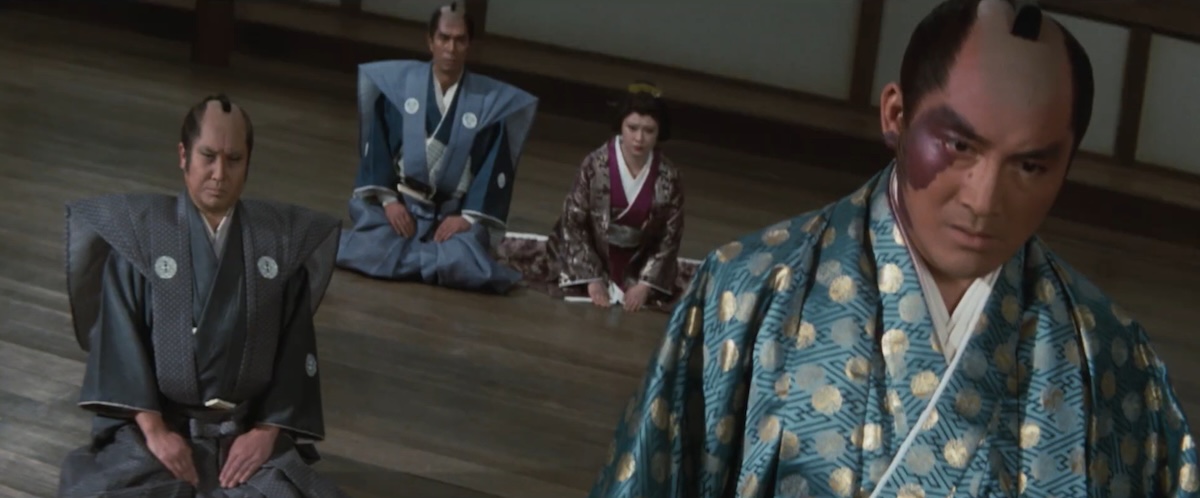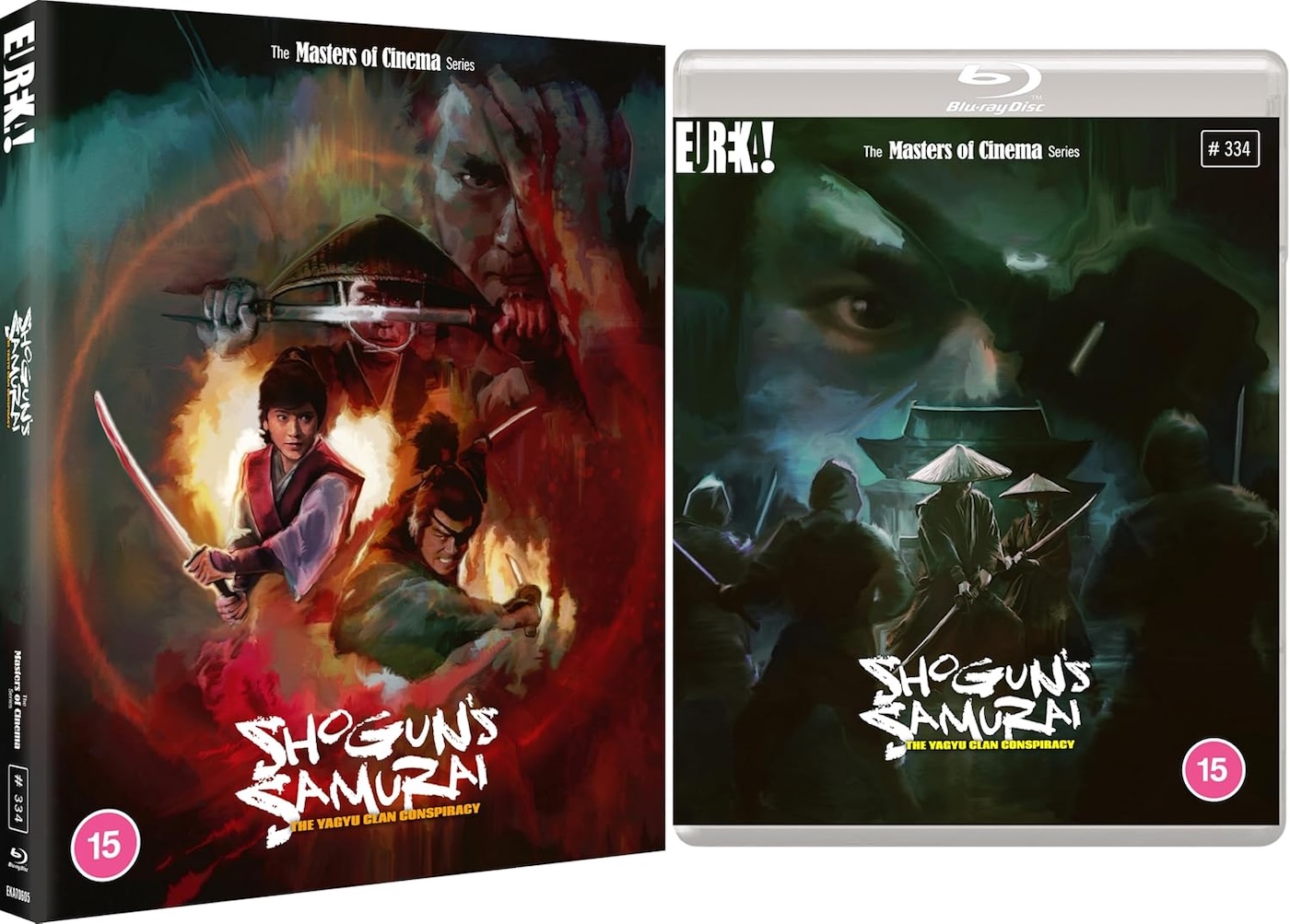SHOGUN’S SAMURAI (1978)
After the Tokugawa shogun's death by poisoning, his two sons compete for the shogunate, dividing the land into warring factions.

After the Tokugawa shogun's death by poisoning, his two sons compete for the shogunate, dividing the land into warring factions.


Shogun’s Samurai, known in Japan as The Yagyū Clan Conspiracy / 柳生一族の陰謀, is a visually splendid and narratively complex samurai thriller, and is newly restored at 4K by Toei, and presented as the latest addition to Eureka Entertainment’s ‘Masters of Cinema’ marque. It begins in 1624, with the untimely death of the second Tokugawa Shōgun, Hidetada, in suspicious circumstances. He died suddenly without naming his successor, though it was rumoured that he favoured his youngest son Tadanaga (Teruhiko Saigô) over the elder Iemitsu (Hiroki Matsukata).
This uncertainty amplifies rivalry between various factions as different lords pledge allegiance to each heir apparent, while the nobility, mainly agitated by Ayamaro Karasumasu (Mikio Narita), vie to destabilise the Shōgunate entirely in the hope of regaining their power and control over the country. So, what if it came out that Hidetada had been assassinated by any one of those factions? War would certainly ensue.
Soon after being laid to rest, a band of ninja desecrate the Shōgun’s funerary temple and remove the corpse’s stomach, but are interrupted by another group of rival ninja who, during the skirmish, recognise one of the organ thieves as Akane (Etsuko Shihomi), a daughter of Yagyū Tajima-no-Kami Munenori (Kinnosuke Nakamura), a renowned samurai fencing master. He confirms that the stomach contains a lethal dose of arsenic and suspects a small cabal of retainers loyal to Iemitsu are responsible. With the help of his eldest son, the legendary rōnin Jubei (Sonny Chiba), he first rouses the support of the displaced Negoro clan who have been granted refuge on Yagyū lands. By a devious campaign of misinformation, betrayals, and staged ‘false flag’ attacks, he sets about influencing affairs for his own nefarious purposes.

Now, if that all sounds like a bit of a complicated premise, you’d be correct. Kinji Fukasaku and his scriptwriting collaborators, Hirô Matsuda and Tatsuo Nogami, expertly imbue the narrative with a sense of historical authenticity that belies the liberties they’ve taken with the documented facts.
Historically, Iemitsu became the third Shōgun of the Tokugawa Shōgunate, although there was some doubt cast over his parentage, and apparently some official documentation regarding his ascension to the position is lost. However, he officially took charge in 1623 and would be responsible for further restricting the power of the emperor and placing stricter rules governing many daimyō—Samurai lords who ruled over their hereditary domains known as han. He also persecuted Christians and issued a series of edicts to expel foreigners, culminating in the Sakoku Edict of 1635, which effectively began a period of isolation for Japan that lasted more than two centuries. In other words, he had a huge influence on the nation’s destiny.
The events of Shogun’s Samurai occur during the power play between rival factions leading up to his installation as Shōgun and cleverly interweave fiction around historical events. This approach of presenting an alternative history and exploring things that may have happened, but of which no record survives, was a nascent sub-genre at the time. Outside the cinema of Japan, the most obvious example of a similar ‘shadow history’ would be Bob Clark’s Murder by Decree (1979), released a year later, which also propounds a conspiracy involving the government and rulers of a nation during a pivotal point in its history.

The central performances are all outstanding and somehow manage to evoke deep emotional responses, particularly to several heroic deaths, even though the characters involved only have limited screen time. An impressive achievement for both cast and director. Kinnosuke Yorozuya—who would also shine in Fukasaku’s The Fall of Akō Castle (1978)—is superbly restrained yet powerful. He was a kabuki-trained actor and reportedly clashed with Fukasaku over acting methods, preferring theatrical gravitas to the director’s modern realism. This tension adds an extra dimension to his portrayal of the scheming Yagyū clan patriarch who is also wrestling with the passing of the old and the dawn of a new era.
Both the gorgeous costumes and sumptuous interiors are fully exploited by cinematographer Tôru Nakajima. His seven previous films had been gritty yakuza tales—all but one with Kinji Fukasaku at the helm, including the classic jitsuroku eiga, Hokuriku Proxy War (1977). So, this was a departure for both of them, although they were also working together on the bonkers sci-fi epic Message from Space (1978).
At the time, chanbara movies were considered an exhausted and unmarketable genre, so such a shift was risky. Period films in general had declined in popularity to such an extent that Toei had dismantled their standing sets, which had been overused throughout their heyday in the 1960s and into the early-1970s. Noir-ish detective fare and violent crime dramas ruled the box office—partly down to the success of Fukasaku’s game-changing yakuza sagas, beginning with Battles Without Honour and Humanity (1973).

A need to build extensive sets would have ramped up the budget for Shōgun’s Samurai, although I suspect Toei would have refurbished their mothballed props and costumes. It seems that with a top director on board, they were prepared to dedicate considerable resources to recapture their past glories, founded upon so many classic jidaigeki. Rivals Daiei had already proven the appeal of action films based around ninja conspiracies with their Shinobi franchise (1962-1973), the initial trilogy also playing out during the same historical period that saw the re-establishment of Shōgunate rule in Japan.
The narrative is perhaps a little over-reliant on dialogue-driven scenes where superiors gather reports of what is happening with rival clans and then invite strategic suggestions from their samurai. However, such necessary exposition is punctuated by enough short but effective battle scenes with plenty of extras. Though these sequences can be difficult to keep track of, Fukasaku handles them well. The disc-like jingasa hats, made from pale rice straw, worn by some of the soldiers, add a graphic element to the battle scenes, allowing for these geometric shapes to be choreographed into dynamic compositions.

The one major drawback is that anyone lacking a rudimentary familiarity with the historical period will find it nigh-on impossible to follow. On the whole, this presented no obstacle to Japanese audiences, who were familiar with this crucial turning point in their country’s past. Shogun’s Samurai was a huge hit, and although budget and box office details are a little sketchy, it has been estimated to have been one of the most popular movies in Japan for 1978, rivalled only by Kinji Fukasaku’s near-perfect period drama The Fall of Akō Castle. Together, they successfully revived interest in period samurai sagas for a new generation by adding the dynamic energy and complex intrigue of gangster epics. Shōgun’s Samurai re-tooled the genre, making it culturally relevant once again by deliberately fusing traditional narrative conventions with a modern frenetic energy, and even blending the mannered acting approaches of kabuki with fashionable naturalistic styles.
Shogun’s Samurai was nominated for five Japan Academy Film Prizes, including Sonny Chiba for ‘Best Supporting Actor’ as Jubei, a role considered to be a turning point in his career. He was to expand on his portrayal of this much-mythologised character in another audacious genre mash-up for Kinji Fukasaku’s excellent Samurai Reincarnation (1981), this time fusing gothic horror and fantasy with the historic epic. Shogun’s Samurai was also adapted for television as the Kansai Television series The Yagyū Clan Conspiracy (1978–79), which I assume gave the story a little more room to breathe across its 39 episodes.
JAPAN | 1978 | 130 MINUTES | 2.35:1 | COLOUR | JAPANESE



director: Kinji Fukasaku.
writers: Kinji Fukasaku, Hirô Matsuda & Tatsuo Nogami.
starring: Kinnosuke Yorozuya, Sonny Chiba, Hiroki Matsukata, Teruhiko Saigō, Reiko Ōhara, Yoshio Harada, Etsuko Shihomi, Isao Natsuyagi, Mikio Narita & Toshirō Mifune.
